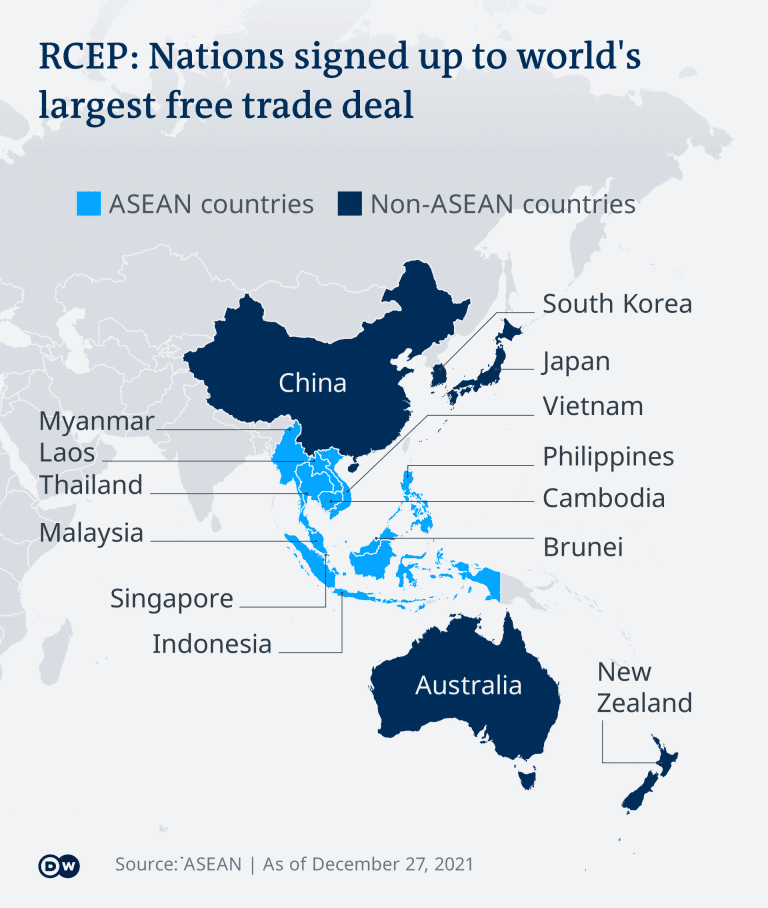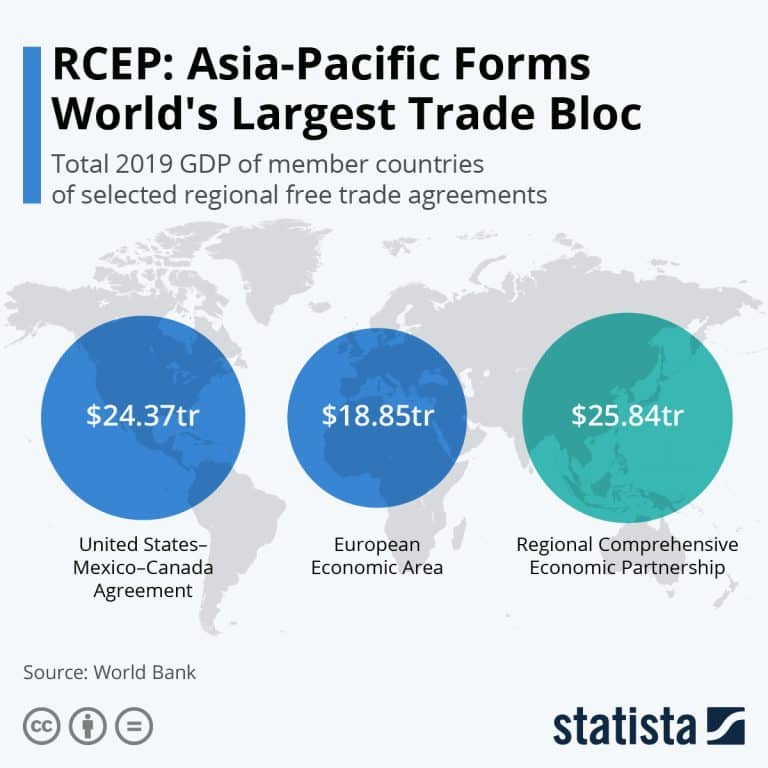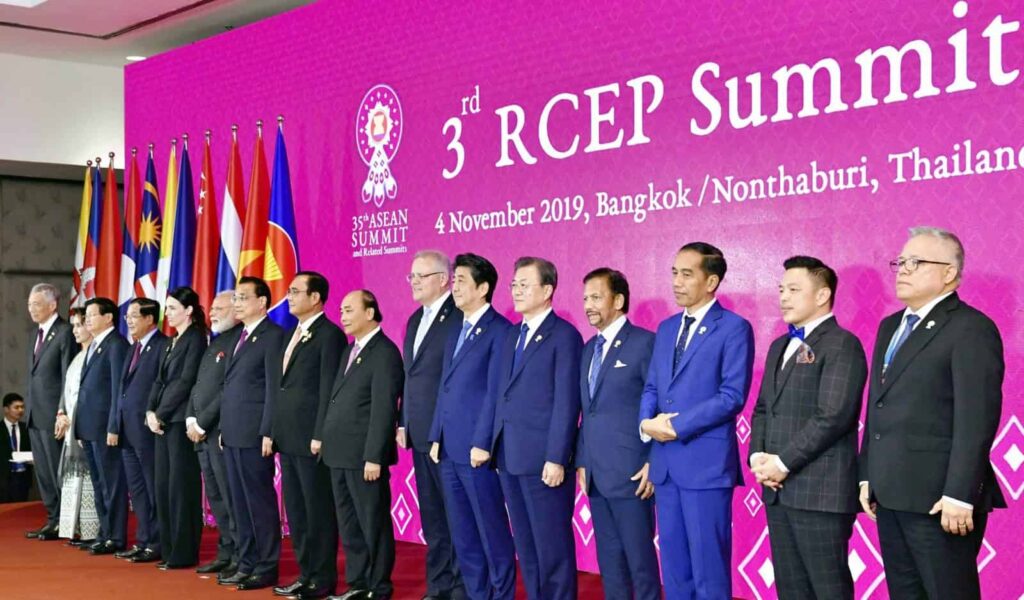The Regional Comprehensive Economic Partnership (RCEP) is making headlines as the latest trade agreement to hit the global business community. This free trade agreement involves 15 member countries, making it the first of its kind among the largest economies in Asia. But what is the RCEP, and why is it such an important development? In the last installment of our free trade agreement mini-series, we’ll provide you with a comprehensive overview of the RCEP, Asia’s most important FTA including its timeline, importance, purpose, and highlights.
What is the RCEP? The new trade deal between Asia’s largest economies
The RCEP is a recent trade deal signed in November 2020 between the nations of Southeast Asia and their trading partners in the Asia-Pacific region. The agreement includes the largest economies in Asia, covering most of Eastern Asia and Australia, with 15 member countries including Australia, Brunei, Cambodia, China, Indonesia, Japan, Laos, Malaysia, Myanmar, New Zealand, Philippines, Singapore, South Korea, Thailand, and Vietnam. The agreement is one of the largest free trade agreements in history, covering nearly a third of the global population and approximately 30 percent of the global GDP.

Source: DW – Map of RCEP Member States
Timeline & Importance of the RCEP agreement
China first proposed the Regional Comprehensive Economic Partnership (RCEP) in 2011 in response to the Trans-Pacific Partnership (TPP), a Free Trade Agreement (FTA) that was being negotiated and led by the United States, without including China. This raised concerns about the exclusion of the world’s second-largest economy from an important trade agreement in the Asia-Pacific region. However, in 2016, US President Donald Trump withdrew the US from the TPP, leaving a void that the RCEP was able to fill.
Negotiations for the RCEP began in 2012, and originally India played a significant role in the agreement’s development. However, in 2019, India decided against joining the agreement citing concerns that the agreement being negotiated would put India’s industries at a disadvantage compared to China. Indian policymakers feared that the agreement would result in Chinese goods flooding the Indian market, causing significant damage to the country’s economy.
After almost eight years of negotiation, the agreement was signed in November 2020. A significant reason behind the member states’ support of the agreement was to transform the web of bilateral agreements many ASEAN countries had with one another to one multilateral agreement that included the whole ASEAN community and the other economies of Asia-Pacific. The agreement entered into force on January 1, 2022.
The influence of the RCEP on global trade cannot be overstated. The agreement will significantly impact trade in Asia, increasing the region’s trade and productivity while also strengthening regional supply chains. Furthermore, due to the size and influence of its member states, the RCEP will also likely significantly impact global trade. The RCEP is the largest FTA in terms of GDP, outranking both that of the Eurozone and the USMCA.

Source: Statista – GDP Comparison of USMCA, EU and RCEP
The RCEP: Building an Integrated Market and Reshaping Global Trade
The RCEP was proposed with the objective of establishing a modern, comprehensive, high-quality, and mutually beneficial economic partnership that would facilitate the expansion of regional trade and investment and contribute to global economic growth and development. The agreement builds on existing bilateral ASEAN agreements.
The RCEP aims to create an integrated market, improving the availability of products and services across the region. The final agreement consists of 20 Chapters relating to trade in goods, trade in services, investment, temporary movement of natural persons, rules of origin, customs procedures and trade facilitation, trade remedies, intellectual property, competition, government procurement, and institutional provisions.
One of the main goals of the RCEP is to create an integrated market that improves the ease and availability of products and services across the region. As part of this goal, tariffs on more than 65% of trade in goods are expected to reach zero and this figure is expected to rise to over 90% of goods traded over the next 20 years. Additionally, the agreement simplifies customs procedures and enhances trade facilitation provisions to allow for more efficient administration of procedures and clearance of goods. The RCEP also provides additional preferential market access for specific products in selected markets, with streamlined rules of origin giving businesses greater flexibility to tap into preferential market access benefits. Furthermore, regional cumulation provisions within the agreement allow businesses to take advantage of regional supply chains, further promoting trade and investment among member states.
Apart from the benefits of an integrated market, the RCEP also expands the scope and commitments in new areas such as E-Commerce, Competition policy, and Intellectual Property Rights. This expansion aims to promote innovation, protect intellectual property, and create a level playing field for businesses operating within the region.
Geopolitical Significance of the RCEP
Given the expected impacts on the world economy, the RCEP also expands beyond the typical FTA provisions in terms of goods and also includes provisions in services and investments. Furthermore, the RCEP is reshaping global trade as it marks the first case in which China has entered a multilateral regional trade agreement. The agreement is expected to help China strengthen its relations with its regional neighbors, further promoting Northeast Asian Economic Integration.
The RCEP is expected to significantly change the makeup of the global GDP as we know it today. While it currently accounts for one-third of the global GDP, it is projected that by 2050, the RCEP will account for nearly half of the global GDP. The RCEP is also expected to generate significant gains for the world economy. It is anticipated that the RCEP could add $209 billion annually to world incomes and $500 billion to world trade by 2030. The RCEP will also play a significant role in potentially offsetting the global losses that were a result of the U.S.-China trade war.
In conclusion, the RCEP is not only expected to have significant impacts on global trade and the world economy, but it also holds large geopolitical significance. The RCEP is a revolutionary agreement aimed at establishing a modern, comprehensive, and mutually beneficial economic partnership. The agreement is expected to have significant impacts on global trade and the world economy, as well as large geopolitical significance. The RCEP is anticipated to promote trade and attract investment to member states, simplifying customs procedures and enhancing trade facilitation provisions, and expanding the scope and commitments in new areas such as E-Commerce, Competition policy, and Intellectual Property Rights. The agreement is expected to strengthen the trade relations of multiple regions and potentially restructure the hierarchy of the world economy.
More from ResearchFDI:




